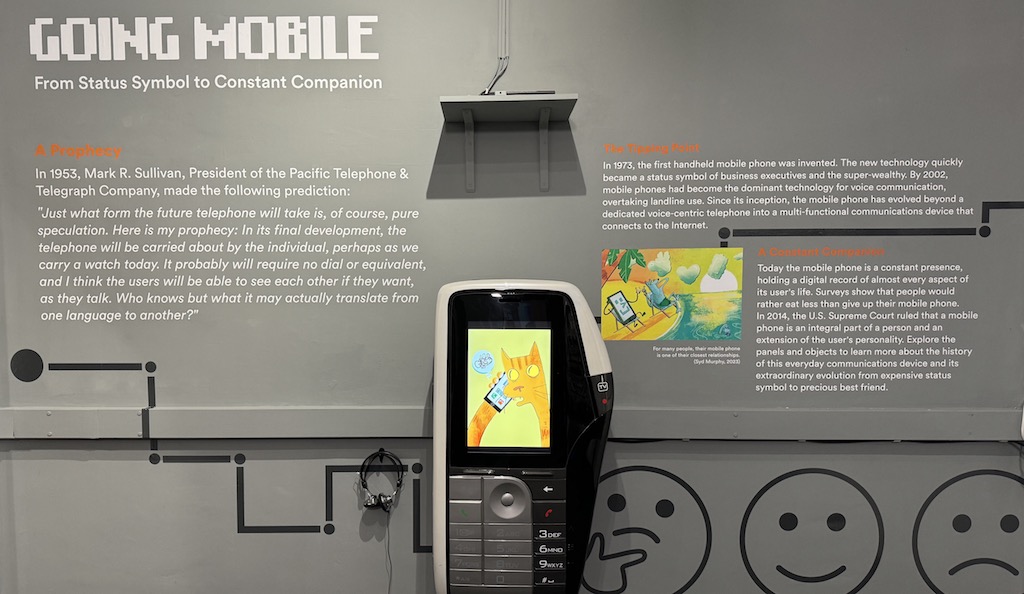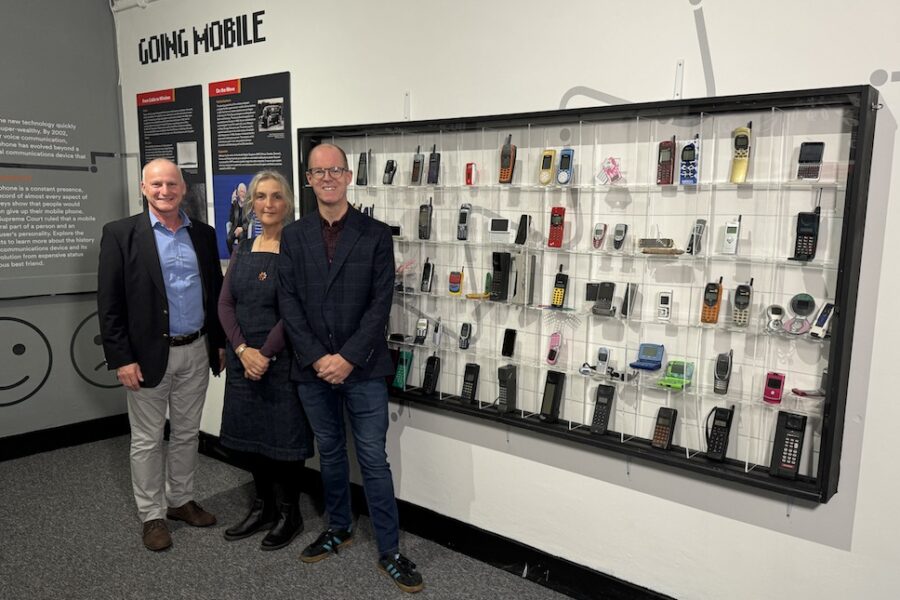Main image: Vodafone’s Ker Anderson, PK Porthcurno, Museum of Global Communication’s Julia Twomlow and Mobile Phone Museum Founder, Ben Wood
A new pop-up exhibition, Going Mobile, was launched at the weekend at PK Porthcurno, Museum of Global Communications, in collaboration with the Mobile Phone Museum, illustrating the 40-year history of the technology and its connection to the Victorian telegraph.
Curated by PK Porthcurno, Going Mobile displays more than 70 phones and objects selected from the Mobile Phone Museum’s unique collection of 2,700 devices for the first time.
They range from the earliest ‘brick’ devices of the 1980s, through flip phones, sliders, and clamshells, to the first camera phone, the first phones with GPS and MP3 players, to the latest smartphones.

The exhibition also traces the development of mobile phone communications and its roots in the history of cable and wireless technology, dating back to the 1840s with the coastal Cornish village of Porthcurno establishing itself as the centre of international telecommunications and once boasting the largest telegraph station in the world.
“The mobile phone uses a network of fibre optic cables, the descendant of the copper-cored electric telegraph cables,” says Charlotte Todd, Head of Collections and Engagement, PK Porthcurno – Museum of Global Communications.
“The first telegraph cable to be laid into Porthcurno was in 1870, connecting Britain to India and allowing a message to be transmitted in just nine minutes, as opposed to the three months it would take by packet ship.
“In just ten years there was almost 100,000 miles of undersea telegraph cables connecting countries around the globe. Undersea telegraph cables revolutionised the way the world communicated, and the mobile phone represents the continuation of this amazing and progressive story”.

The exhibition displays use a combination of photos, objects, illustrations, and animations, to explain:
• the evolution of the mobile phone ‘generations’
• how a mobile phone call works
• the timeline of mobile milestones
• the role of the mobile phone industry in social, economic, and environmental questions
• how the mobile phone has become an extension of ourselves
Ben Wood, Founder of the Mobile Phone Museum, says the museum’s first public exhibition will provide a new wave of interest in the Mobile Phone Museum project and act as a blueprint for future pop-up exhibitions.
“Our goal was always to have somewhere people could visit and the idea of a pop-up museum was very appealing,” he says. “Once we started working with Julia Twomlow, the Creative Director and CEO of PK Porthcurno, we realised it was a great opportunity for us to learn about how to curate a physical exhibition.”
The idea of working with PK Porthcurno started in early 2022 when Wood and his wife, who is from Cornwall, visited the museum several times and wondered if there was an opportunity to work together.
The Stars Aligned

“The stars aligned when we realised that the PK Museum is sponsored by the Vodafone Foundation. Given that the Mobile Phone Museum’s primary sponsor is Vodafone UK it made sense to see if there were opportunities to collaborate.”
Wood, who is also Chief Analyst and CMO at CCS Insight, is understandably passionate about mobile phones and says no other invention in recent memory has shaped how we live more fundamentally than the mobile phone.
“From mobile payments to citizen journalism, always-on social media and the ability to work anywhere, it’s difficult to overstate the importance of this device, which has become the most prolific consumer electronics product on the planet.
History of Communications

“And having got in touch with the team at Porthcurno it was clear there was great enthusiasm from both sides to see what was possible and real synergies given the focus on the history of communications.”
Wood established the Mobile Phone Museum as a virtual museum on 2019 and hosted online at mobilephonemuseum.com after conceiving the idea 15 years earlier in 2004.
He said when he and a small team started the project they did not think it was realistic to have a physical museum given the ongoing costs and time involved. Then in 2020 the Covid-19 pandemic started so it really was a non-starter to think about having a permanent physical location.
Read more in our in-depth interview with Ben Wood
“We also felt that a virtual museum hosted online gave us an opportunity to have global reach with relatively limited overheads. Also, it gave us a chance to build the collection and the collateral that went with it. This is something we’ve been able to leverage in the in-person museum.
“However, [the opportunity to use] a flexible exhibition space that was available for a one-year made perfect sense for it to be the first place to give the public an opportunity to see some of the iconic devices that form part of the Mobile Phone Museum collection.”
Extensive Expertise
Wood says he has been able to take advantage of the extensive expertise that the Porthcurno museum team have in producing a pop-up exhibition.
“There is a huge amount of work involved to conceive, develop, and curate the content and we have learnt so much as the project has evolved. It feels like a perfect fit and will hopefully provide the blueprint for further exhibitions in future.
“Working with PK Porthcurno will also help us to continue developing the education goals for the Mobile Phone Museum charity with a focus on inspiring the next generation of engineers and designers in the UK by using our extensive collection of devices and learning resources.”
Going Mobile runs at PK Porthcurno, Museum of Global Communications until October 2024.
